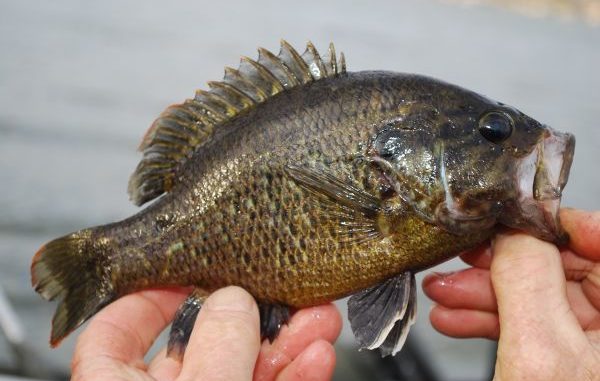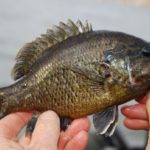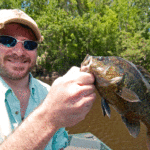
The freshwater fish family Centrarchidae, commonly called the sunfish family, is arguably the most-important freshwater fish family for North American sportsmen.
In the southeastern United States it is without doubt the most important.
The family includes black basses (largemouth, smallmouth, spotted and several minor species), as well as two species of crappie and a host of smaller fish commonly lumped together as “bream.”
Bluegills are the best known of the bream group, but my personal favorite is the goggle-eye — or, more formally, the warmouth.
Click here to see a video about how to catch boxes full of goggle-eyem along with other bream.
Its scientific name is Lepomis gulosus. The genus name, Lepomis, means “scale cover” in Greek. The cover probably refers to the operculum or gill cover.
The species name, gulosus, in this instance really fits: It means “large-mouthed” in Latin.
Goggle-eye have large mouths for a reason. This beautiful little fish is an absolute glutton, eating anything that will fit in its roomy mouth.
Most bream have a dietary specialty. That’s how eight species fit in Louisiana. Each eats a little something different or lives in a slightly different habitat and that keeps competition down.
For example, red ear sunfish (chinquapin) specialize in feeding on mollusks (like snails) and, to a lesser degree, small crustaceans like grass shrimp. It almost never feeds at the water’s surface.
Bluegills share the same habitat as red ears, but have a different food niche. Their bag is bugs — insects of all types. An insect that falls in the water is often snatched before it even has time to sink.
They also feed heavily on the worm-like larvae of midges — small water-loving flies.
And, like red ears, plant material also makes up much of their diet. What is seldom found in their stomachs are mollusks, fish and large crustaceans like crawfish.
As for our hero the warmouth, the only thing it seems to not eat is plants.
Research done in the Okefenokee Swamp in Georgia paints a pretty typical picture of what goggle-eyes eat.
From 1 to 3 inches long, they ate mainly insects, especially midge and dragonfly larvae. Freshwater shrimp, small fish and some crawfish were also eaten.
By 3 to 5 inches long, they increased their consumption of fish, crawfish and especially freshwater shrimp, although insects still remained their No. 1 food item.
Goggle-eyes 5 to 7 inches long ate fewer insects and shrimp and a lot more fish and crawfish.
The largest goggle-eyes, those over 7 inches long, ate fewer insects and, surprisingly, fewer fish. But they ate dramatically more crawfish.
Goggle-eyes are not choosy where they feed, and will strike a baited hook at the water’s surface or pick it up off the bottom with equal enthusiasm.
Goggle-eyes are not swift-water fish, preferring sluggish bayous or lakes. They are especially partial to aquatic weed beds and stumps.
Goggle-eye heaven is a stump in a weed bed.
During the summer, a bait dropped near a stump will often produce an instant strike, most often from a big pot-bellied and brightly colored male. Another bait dropped in the same spot often seduces the less brightly colored and smaller female.
Goggle-eyes are not spooky fish, and it’s a good thing. Sometimes you make a lot of racket getting your bait back into the brushy, snaggy, plant-ridden spots in which they live in.
Anglers can use their pole tip to clear a spot in the mats of duckweed, and then pull fish after fish out of the cleared spot.
Goggle-eyes are gorgeous fish, one of the most-colorful freshwater fish in the South.
Color varies with water color. Goggle-eyes are typically a mottled green color, and when taken from clear, black swamp water, their body will be backlit with red, blue and green highlights.
Most impressive are the eyes, which in large males can be blood red.
Members of this fish family are known for building and guarding nests.
Most species look diligently for firm bottoms on which to build their nests, and are so particular that if no firm bottoms are found they will build their nests on stumps and logs.
Not Mr. Goggle-eye. He avoids areas of clear sand in favor of a silty debris bottom, near some sort of cover.
A ready-to-spawn male develops even brighter body coloration and redder eyes. It approaches a female with its mouth open and its gill covers flared, looking for all the world like a pint-sized grouper.
Spawning takes place in typical bream fashion, with a male and female doing a side-to-side dance, with their bodies often touching. They swim in a circular motion over the nest site that the male has prepared by sweeping with its tail. The female discharges eggs, and the male spreads sperm for chance fertilization.
Males will court and mate with several females, but the reverse is not true. Unlike some other bream species, a female will spawn only once a year. Perhaps this is the reason they are less common than other species of bream.
Spawning activity peaks in May, but can continue to August.
While goggle-eyes are chunky and will average, fish-for-fish, larger than bluegills and red ears, they apparently don’t grow as large as the largest of the other two species.
The largest red ear on record is a 5-pound, 8-ounce monster caught in Arizona in 2011. The IGFA world record bluegill is 4-pounds, 10-ounces and dates from 1950.
Compared to these two, the world record warmouth is only 2-pounds, 11-ounces.


